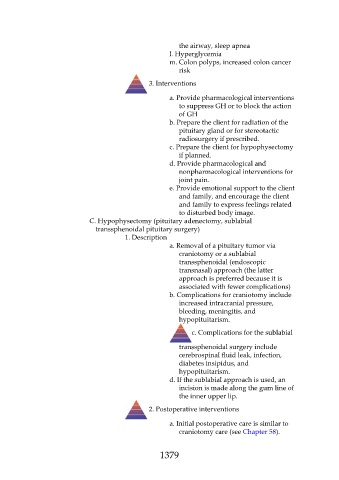Page 1379 - Saunders Comprehensive Review For NCLEX-RN
P. 1379
the airway, sleep apnea
l. Hyperglycemia
m. Colon polyps, increased colon cancer
risk
3. Interventions
a. Provide pharmacological interventions
to suppress GH or to block the action
of GH
b. Prepare the client for radiation of the
pituitary gland or for stereotactic
radiosurgery if prescribed.
c. Prepare the client for hypophysectomy
if planned.
d. Provide pharmacological and
nonpharmacological interventions for
joint pain.
e. Provide emotional support to the client
and family, and encourage the client
and family to express feelings related
to disturbed body image.
C. Hypophysectomy (pituitary adenectomy, sublabial
transsphenoidal pituitary surgery)
1. Description
a. Removal of a pituitary tumor via
craniotomy or a sublabial
transsphenoidal (endoscopic
transnasal) approach (the latter
approach is preferred because it is
associated with fewer complications)
b. Complications for craniotomy include
increased intracranial pressure,
bleeding, meningitis, and
hypopituitarism.
c. Complications for the sublabial
transsphenoidal surgery include
cerebrospinal fluid leak, infection,
diabetes insipidus, and
hypopituitarism.
d. If the sublabial approach is used, an
incision is made along the gum line of
the inner upper lip.
2. Postoperative interventions
a. Initial postoperative care is similar to
craniotomy care (see Chapter 58).
1379

